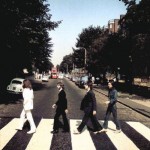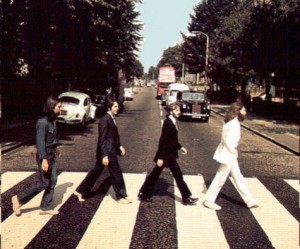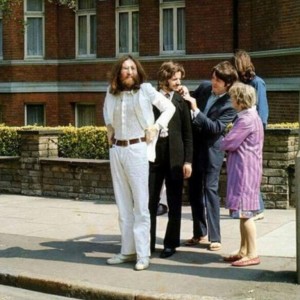A photographer called Iain Macmillan was a friend of John and Yoko and, during the morning of Friday 8 August 1969 found himself commissioned to take a photo of the Fab Four to adorn their latest studio release, an album called Abbey Road.
For the shoot, Iain Macmillan used a Hasselblad camera with a 50mm wide-angle lens, aperture f22, at 1/500 seconds.
As the group waited outside the studio for the shoot to begin, Linda McCartney took a number of extra photographs, one of which can be seen here on the right.
8 August 1969 was a warm day in London. Paul McCartney wore sandals.
A policeman was positioned at the junction of Abbey Road and Grove End Road, behind the photographer, and temporarily stopped the traffic. Macmillan mounted a stepladder for a few minutes and took six shots while the Beatles crossed the zebra crossing.
In four of the photographs McCartney walked barefoot; for the other two he wore his sandals.
The photograph was taken about 11.30am and about the same time, a continent away, Charles Manson and his “family” were about to slaughter Sharon Tate and her house guests in Southern California. Manson was obsessed with the Beatles music, particularly the track Helter Skelter from the White Album which he cited as his motivation for killing.
As the Beatles Bible writes: “Shortly after the shoot, McCartney studied the transparencies and chose the fifth one for the album cover. It was the only one when all four Beatles were walking in time. It also satisfied The Beatles’ desire for the world to see them walking away from the studios they had spent so much of the last seven years inside.”
 The VW Beetle featured in the final photograph belonged to Malcolm Tanner who lived in the block of flats across from the recording studio – he kept a spare set of keys for the car even after its sale. After the album was released, the number plate (LMW 281F) was stolen repeatedly from the car. In 1986, the car was sold at auction for £2,530 and after 2001 was on display in a museum in Germany.
The VW Beetle featured in the final photograph belonged to Malcolm Tanner who lived in the block of flats across from the recording studio – he kept a spare set of keys for the car even after its sale. After the album was released, the number plate (LMW 281F) was stolen repeatedly from the car. In 1986, the car was sold at auction for £2,530 and after 2001 was on display in a museum in Germany.
The man looking back towards the camera was named Paul Cole. He died in 2008.
In Linda McCartney’s photo, the lady in the purple stripped coat talking to Ringo was a neighbour of the studios.
 Once the cover was released with the fifth photo chosen, it was reported to contain “clues” that Paul was dead. Part of the VW number plate read 281F — he’d be “28 if” he lived. His eyes are closed, he’s out of step with the others, he’s smoking and he’s barefoot (as are bodies when buried). The others are dressed – John in white as a preacher, George in jeans like a gravedigger, Ringo in black like a pallbearer.
Once the cover was released with the fifth photo chosen, it was reported to contain “clues” that Paul was dead. Part of the VW number plate read 281F — he’d be “28 if” he lived. His eyes are closed, he’s out of step with the others, he’s smoking and he’s barefoot (as are bodies when buried). The others are dressed – John in white as a preacher, George in jeans like a gravedigger, Ringo in black like a pallbearer.
After the Beatles completed their album cover photo shoot, Iain Macmillan explored the surrounding neighbourhood for additional opportunities. He discovered a street sign at the corner of Abbey Road and Alexandra Road, which he utilised for the back cover of the album. The junction where that photo was taken no longer exists; it was later replaced by the Abbey Road housing estate.
After the album’s release, its cover became iconic. The zebra crossing is now listed and a spot on the London tourist circuit. Such was the impact of the album, EMI Studios was renamed Abbey Road studios and became famous worldwide.
Photos: Iain Macmillan/Linda McCartney


